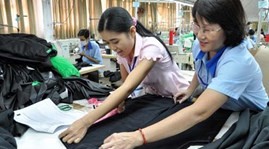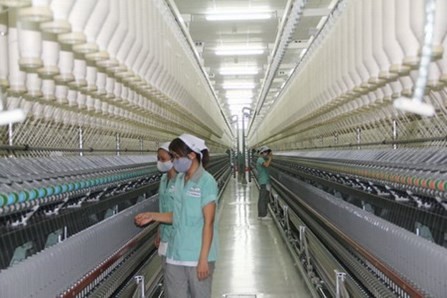(VOVworld) - The Trans-Pacific Partnership agreement is entering the final stretch of negotiations. Economists say once Vietnam joins the agreement, its exports can enjoy the agreement’s great benefits, especially the garments and textiles sector. But it will also impose many challenges requiring domestic garment manufacturers to actively prepare themselves to meet its conditions.

Vietnam's garments and textiles sector is likely to enjoy great benefits from the TPP . |
The TPP is a trade deal covering various areas accounting for 40% of global GDP and 30% of global trade. The 12 TPP members include the US and Japan, Vietnam’s principal importers. Under the TPP, Vietnam’s garment and textile exports to the US, which make up 55% of the total, will enjoy a tariff of 0%. The current import tariff is 17.5%.
However, Vietnamese apparel enterprises will face challenges satisfying TPP standards. To benefit from the tax breaks, apparel must be made of yarn and other materials produced in TPP member countries.
To meet this requirement, Vietnamese garment manufacturers are trying hard to increase localization and promote investment in Vietnamese material zones. Le Tien Truong, Deputy Director of the Vietnam National Textile and Garment Group (Vinatex), say:
“The roadmap to prepare for the sector to integrate internationally is on the right track. Vietnam has focused on increasing added value of domestic products, localization rates in all phases, particularly designing and sources of materials. The process has taken place for decades since Vietnam began bilateral negotiations of a free trade agreement with the US, the WTO, and now the TPP.”

Investment in yarn production projects far exceeds investment in garment projects. |
Vietnam’s apparel industry is focused now on meeting the TPP’s rule about origin of yarn. Vinatex’s Deputy Director Truong said Vinatex will do its best to comply, but it will require a huge amount of investment capital. Truong noted: “To date, I can say for sure that the rule about origin of yarn is an integral part of the TPP agreement. If we don’t make careful preparations for this, it’ll be hard for us to receive TPP benefits, so we have invested in 21 material production projects in yarn and weaving. Investment in yarn production projects far exceeds investment in garment projects. This reflects the sector’s orientation toward sustainable growth.”
Vinatex and relevant agencies are promoting activities to help the sector’s businesses improve their competitiveness against foreign investors in supplying local materials. Dau Anh Tuan, head of the legal department of the Vietnam Chamber of Commerce and Industry, has this to say:
“Foreign investors are paying great attention to TPP negotiations and the rule about origin of yarn. As a result, Vietnamese businesses, especially small and medium sized enterprises, should also keep up to date on this issue.”
In 2014, Vietnam’s garments and textiles sector has a growth target of more than 10% with export turnover of 23 billion USD. According to the Vietnam Garment and Textile Association, Vietnam apparel exports are likely to experience many advantages because the major buyers – the US, the EU, Japan, and the Republic of Korea – are forecast to have better growths independent of the possible success of the TPP.